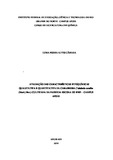Avaliação das características fitoquímicas qualitativa e quantitativa da Caraibeira (Tabebuia caraíba (Mart.) Bur.) cultivada na fazenda escola do IFRN - Campus Apodi

Visualizar/
Data
2019-12-18Autor
Câmara, Luma Misma Alves
http://lattes.cnpq.br/2913946174763930
Metadado
Mostrar registro completoResumo
The use of plants for medicinal purposes has followed the human being since the first centuries, its use for a long time represented the only source of medicinal material. Plants that carry medicinal power play an important role in the development of modern medicine. Due to its immense biodiversity, Brazil has been increasingly investing in phytochemistry, through studies and research. Native to the Caatinga biome, Tabebuia caraíba is popularly used for its expectorant and antipyretic action. This characteristic and the scarcity of studies that investigate the nature of these activities, aroused interest in the research of Tabebuia caraiba (Mart.) Bur. (caraibeira), grown at the School Farm of the Federal Institute of Education, Science and Technology of Rio Grande do Norte, Apodi
campus. Using the methodology obtained from the work of Matos (1997), it was possible to obtain data on the chemical characteristics of three parts (branches, leaves and trunk) of the species native to the region. The methodology used for the quantification of Anthocyanins in the samples was by the Teixeira method, where the leaves obtained the highest result of 5.040 mg / 100g of the evaluated sample. To obtain the quantification of tannins in the samples it was by the method of Broadhust and Jones (1978), with the highest result for leaves, with a tannin content of 1506 ppm. As well as acquired qualitative data of the secondary metabolites present in the analyzed species, such as flavonoids, catechins, anthocyanidins, triterpenoids, steroids, phenols, tannins, leucoanthocinidines. The tests performed showed excellent results compared to what the literature reports on other species of medicinal plants.



